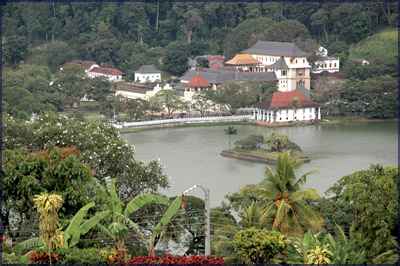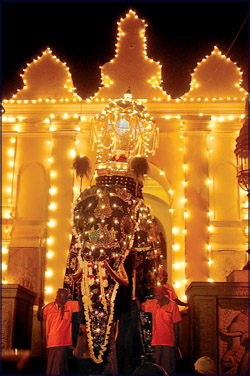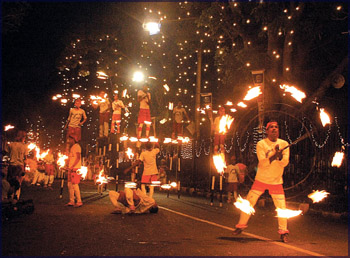The Pageant of Splendour
Lionel WIJESIRI
NATIONAL PRIDE: There can be few festivals in the world to match the Kandy Esala Perahera pageant for passion and splendour. It is an annual
event of great historic, aesthetic and cultural significance that takes
place in the lunar month of Esala.
It has been the subject also of much scholarly study and intense
artistic appreciation. There are several theories and interpretations
regarding the origin of the pageant. One of the main theories is based
on the Sacred Tooth
|

A symbol of National pride: The Sri Dalada Maligawa in Kandy |
Relic, which is indeed in the centre of the
ceremony.
The Sacred Tooth Relic of the Buddha was brought to Sri Lanka from
Kalinga in India in the reign of Kirthi Sri Meghavanna (303-331 AD) and
it has since been the custom to celebrate this event with the highest
esteem and reverence.
However, Sri Lankan chronicles suggest that long before this annual
festival a ritual was held since the 3rd century B.C. in the hills to
propitiate the rain god. It is quite possible that this practice
continued in a new guise in the succeeding centuries along with the
Buddhist Sacred Tooth worship.
Whatever the origins of the Esala Perahera, the general belief is
that the pageant in Kandy commenced in the reign of Kirti Sri Rajasinha
(1747-1781 AD).
At any rate, it was in his reign that the Perahera took its present
form: it is the Dalada Perahera with the amalgamation of the four Devale
Peraheras (processions associated with Hindu deities, Gods Vishnu and
Natha, the Goddess Pattini, and the God Kataragama.
There is another story how the Dalada perahera came to be merged with
the four devale peraheras. When the Bhikkus from Siam (Thailand), headed
by the Most Ven. Upali Maha Thera, came to Sri Lanka, to confer the
defunct ‚ÄėUpasampada‚Äô, their arrival coincided with the Esala festival in
Kandy, when preparations were under way to hold the Devale peraheras
invoking the blessings of the gods for the king and his subjects.
Maha Thera Upali, heard the sounds of jingalls (a kind of large
Indian swivel musket), and inquired from the king what was it about. The
king replied that arrangements were being made to hold the Devale
peraheras, during the month of Esala, to appease the gods and to receive
their blessings.
|

SPECTACULAR: The Maligawa Elephant, a tusker, carries the relic
casket, which is a substitute for the Tooth Relic. |
The Maha Thera showed his displeasure of King giving preference to
Hindu customs, in a country where orthodox Buddhism has gained ground
for more than one thousand years.
The king, realising his mistake decided not to offend the Maha Thera.
He decided that the Dalada Perahera should lead the procession followed
by the Devale peraheras, in their order of importance.
The Kandy Esala Perahera begins with the Kap Situveema, in which a
sanctified young Jack tree is cut and planted in the premises of each of
the four Devales dedicated to the four guardian gods. Traditionally it
was meant to shower blessings on the King and the people.
Thereafter for the next five nights, the ‚ÄúDevale Peraheras‚ÄĚ take
place within the premises of the four Devales with the priest of each
Devale taking the pole every evening, accompanied by music and drumming,
flag and canopy bearers, spearman and the Ran Ayudha, the sacred
insignia of the gods.
On the sixth night, the Kumbal Perahera begins and continues on for
five days.
The Randoli Perahera begins after five nights of the Kumbal Perahera.
Randoli refers to palanquins on which the Queens of the ruling Kings
traditionally travelled.
Initially, the Devale Peraheras assemble in front of the Sri Dalada
Maligawa with their insignia placed on the ransivige (a dome-like
structure) accompanied by the Basnayake Nilames - the lay custodians of
the Devales). There are four palanquins in the Randoli perahera formerly
used by royalty as litters.
They are richly embroidered couched boxed in with curtains are
attached to long poles which act as supports for the bearers who carry
them on their shoulders. The significance of their presence in the
Randoli perahera is that the gods of the four shrines are supposed to
ride in the palanquins as they are carried in the procession.
The relic casket, which is a substitute for the Tooth Relic, is
placed inside the ransivige affixed to the Maligawa
|

colourful: Whip-crackers and fireball acrobats clear the path
for the pageant |
Elephant, a tusker.
At about 8 pm, the Maligawa Perahera joins the awaiting Devale
Peraheras and leads the procession. Whip-crackers and fireball acrobats
clear the path, followed by the Buddhist flag bearers.
Then, riding on the first elephant, is the official called Peramuna
Rala (Front Official). He is followed by Kandyan drummers and dancers
who enthral the crowd, and are themselves followed by elephants and
other groups of musicians, dancers and flag bearers.
A group of singers dressed in white heralds the arrival of the
Maligawa Tusker carrying the Sacred Tooth Relic. The Diyawadana Nilame
(traditionally required to do everything in his power to ensure rain in
the correct season) walks in traditional Kandyan-clothed splendour after
the tusker.
The second procession is from the Natha Devale, which faces the Sri
Dalada Maligawa and is said to be the oldest building in Kandy, dating
back to the 14th Century. The third is from the Vishnu Devale (Vishnu
being a Hindu god), also known as the Maha Devale. It is situated in
front of the main gate of the Natha Devale.
The fourth procession is from the Kataragama Devale (dedicated to the
God of Kataragama, identified with the warrior god Skanda) which is on
Kotugodalle Vidiya (a street in Kandy).
This procession includes Kavadi, the peacock dance, in which the
pilgrim-dances carry semicircular wooden contraptions studded with
peacock feathers on their shoulders.
The fifth and final procession is from the Pattini Devale (Pattini
being a goddess associated with the cure of infectious diseases and
called upon in times of drought and famine), which is situated to the
West of the Natha Devale. This is the only procession that has women
dancers.
The pageant ends with the Diya Kepeema, which is the water cutting
ceremony at the Mahaweli River at Getambe, a town a few miles from Kandy.
A Day Perahera is held to mark the ceremony. Only a section of the
overnight procession accompanied by the kapuralas in charge of the four
shrines of Natha, Vishnu, Kataragama and Pattini proceed to the ferry at
Getambe and await the first light of the day for the performance of the
ritual.
When the first rays of sun fall they draw a circle in water with a
sword. The water within that circle is taken to fill the pitchers.
Although Sri Lanka cannot boast of street carnivals like those in
Brazil, Trinidad or England, the Kandy Esala Perahara is not second to
any of these Western extravaganzas. Besides being an event of
spectacular exuberance it is also an exhibition of religious devotion
and national pride. |

